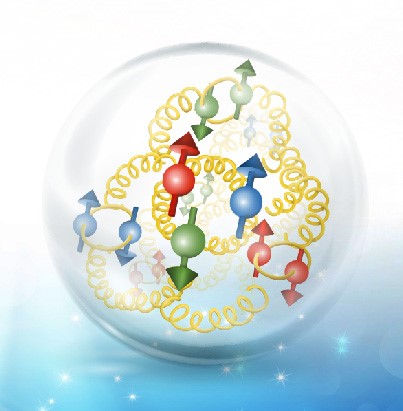The following statement is being issued by the U.S. Department of Energy’s Thomas Jefferson National Accelerator Facility and Brookhaven National Laboratory—along with the Electron-Ion Collider User Group—in response to a report issued today by the National Academies of Sciences, Engineering, and Medicine on the scientific case for a U.S.-based Electron-Ion Collider (EIC). Jefferson Lab and Brookhaven scientists are part of the vibrant community that has come together to tackle the scientific and technological challenges of designing and building a U.S.-based EIC, drawing on the expertise and existing infrastructure at the two labs.
Statement by Jefferson Lab, Brookhaven Lab and the Electron-Ion Collider Users Community on National Academy of Sciences Electron-Ion Collider Report
On July 24, 2018, a National Academy of Sciences (NAS) committee issued a report of its findings and conclusions related to the science case for a future U.S.-based Electron-Ion Collider (EIC) and the opportunities it would offer the worldwide nuclear physics community.
The committee’s report—commissioned by the U.S. Department of Energy (DOE)—comes after 14 months of deliberation and meetings held across the U.S. to gather input from the nuclear science community. The report’s conclusions include the following:
- The committee concludes that the science questions regarding the building blocks of matter are compelling and that an EIC is essential to answering these questions.
- The answers to these fundamental questions about the nature of the atoms will also have implications for particle physics and astrophysics and possibly other fields.
- Because an EIC will require significant advances and innovations in accelerator technologies, the impact of constructing an EIC will affect all accelerator-based sciences.
- In summary, the committee concludes that an EIC is timely and has the support of the nuclear science community. The science that it will achieve is unique and world leading and will ensure global U.S. leadership in nuclear science as well as in the accelerator science and technology of colliders.
The computers and smartphones we use every day depend on what we have learned about the atom in the last century. All information technology—and much of our economy today—relies on understanding the electromagnetic force that controls an atom’s electrons and using that knowledge to manipulate electrons in a beneficial way. Thus, unleashing the power of the electron has made modern life possible.
In the last few decades, scientists have gone beyond the periphery of the atom to begin to plumb the depths of its nucleus and discover how this knowledge can positively impact society over the next hundred years. Modern nanotechnology explores the microscopic world as small as a tenth of a billionth of a meter. Microscopic imaging of the atomic nucleus and its constituents and properties would represent a change in paradigm requiring a very intense, energetic tool that probes the microscopic world at least a million times smaller in size.
For instance, the strongest force in Nature is manifested deep inside the nucleus. The strong force holds quarks together, building protons, neutrons, and the nucleus itself. That’s why physicists want to build a new machine—the Electron-Ion Collider, or EIC—to collide electrons with nuclei and look deep inside the nucleus to reveal the role of gluons, the carriers of the strong force. Revealing the nucleus’ secrets with an EIC will help retain the U.S. global leadership position in nuclear physics for decades to come.
What we learn from an EIC will open a new frontier in physics, inspire the next generation of scientists, and has the potential to power the advanced technologies of tomorrow, benefiting health and medicine, national security, nuclear energy, radioisotope production, and the use of particle beams in industry.
In 2015, the Nuclear Science Advisory Committee (NSAC), advising DOE and the National Science Foundation (NSF), recommended an EIC in its Long Range Plan as the highest priority for new facility construction. Since the publication of the NSAC Long Range Plan, a vibrant community has come together to tackle the scientific and technological challenges of designing and building a U.S.-based EIC, drawing on the expertise and existing infrastructure at Brookhaven National Laboratory in Upton, NY, and the Thomas Jefferson National Accelerator Facility in Newport News, VA. This community of EIC scientists has been growing rapidly, and it is already more than 700 strong, representing more than 150 institutions in 29 countries on five continents. This community recently instituted the Electron Ion Collider User Group (EICUG) with a governance structure and annual meetings intended to develop and promote the scientific, technological, and educational goals and motivations for an EIC.
Just as studies of fundamental particles and forces have driven scientific, technological, and economic advances for the past century—from the discovery of the electrons that power modern life to the understanding of the structure of the cosmos—research conducted with an EIC will spark innovation and enable widespread technological advances. And building an EIC and its research program in the U.S. would strengthen and expand U.S. leadership in science and technology and stimulate economic benefits for decades to come.
We are very pleased to see the results of the NAS report. We fully support the committee’s findings and thank its members for their efforts. We look forward to DOE and NSF adopting the committee’s findings, and to working with those agencies and the worldwide nuclear physics community to make the EIC a reality.
— Stuart Henderson
Director, Thomas Jefferson National Accelerator Facility
— Doon Gibbs
Director, Brookhaven National Laboratory
— Bernd Surrow
Chair, EICUG Steering Committee
Professor of Physics, Temple University
Additional Information:
NASEM Report: An Assessment of U.S.-Based Electron-Ion Collider Science
Media Contacts:
JLab Press Contact
https://www.jlab.org/pressroom
Lauren Hansen
Communications Manager
(757) 269-7689
lhansen@jlab.org
BNL Press Contact
https://www.bnl.gov/newsroom/
Pete Genzer
Manager, Media & Communications Office
(631) 344-3174
genzer@bnl.gov
EIC User Group Contact Persons:
Bernd Surrow
EIC User Group Chair
Temple University
(215) 204-7644
surrow@temple.edu
Charles Hyde
EIC User Group Deputy-Chair
Old Dominion University
(757) 683-5853
chyde@odu.edu


